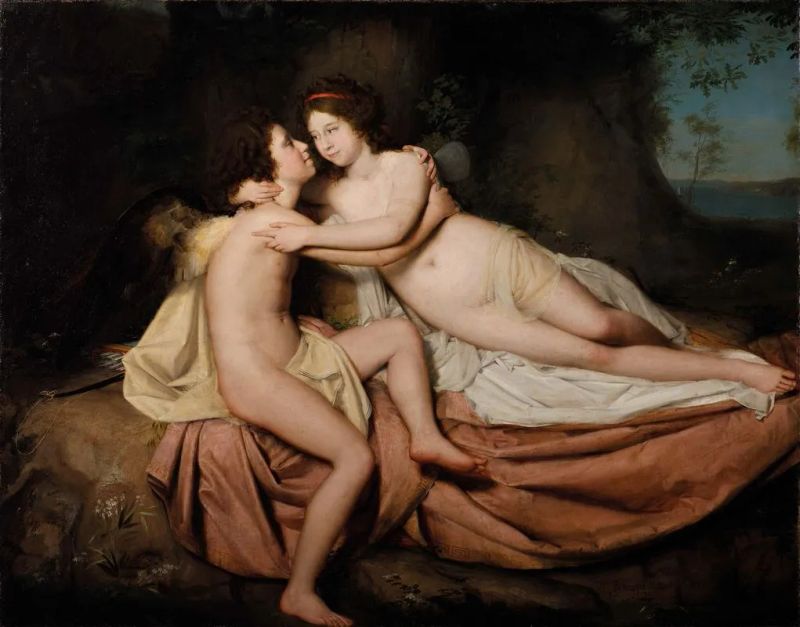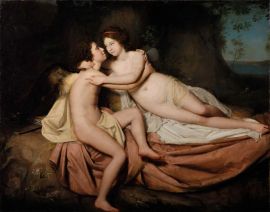Domenico Pellegrini
(Galliera Veneta 1759 - Rome 1840)
PORTRAIT OF FILIPPO AND COSTANZA DE MARINIS AS CUPID AND PSYCHE
oil on canvas, 134x174 cm
signed and dated "D:co Pellegrini F:it Napoli / 1790" lower right
Provenance
Marchese Giovann'Andrea De Marinis, Naples
Principi Sangro di Fondi, Naples
Private collection
Literature
G. Pavanello, Domenico Pellegrini 1759-1840. Un pittore veneto nelle capitali d'Europa, Venezia 2012, p. 17
Under the protection of Antonio Canova, the young Veneto painter Domenico Pellegrini (1759-1840) travelled from Rome to Naples, in order to perfect his studies and to achieve recognition from this artistic centre of excellence. From Naples, he came back to Rome. He later moved first to Venice and then to London, which, together with Lisbon, became the favourite places for his activity. He spent the final years of his life in Rome and he generously donated to the Accademia di San Luca his collection of paintings: first among others, the Capriccio architettonico by Canaletto.
The artist, already renowned in Rome, started to expand his experiences, and, as a reason for his stay, he was appointed by Canova to create a copy of the Danae by Titian, stored in Capodimonte. It was the end of the ninth decade of the XVIII century. An extract by Antonio d'Este in his Memorie sheds light on this period:
It was around that time that the artist (Canova) met Domenico Pellegrini, who, out of the financial support granted to him in Rome by a Venetian aristocrat, found himself without economic means fearing for a gloomy future due to the political situation of that time. In order to help him, Canova sent him to Naples, at his own expenses, to paint a replica of the Danae by Titian: thus Pellegrini, who stood out for his use of colour, began his career and Canova provided for the needs of an artist that, by means of his brush, managed to put aside enough savings to live comfortably[1].
That stay turned out to be fortunate because Pellegrini was supported by the name of Canova, who, at that time, was leader for the commissions of sculptures in the city, starting with the group of Adonis and Venus, already sculpted in 1789 and placed by the Marquis Francesco Berio in a small temple in the garden of his palace in via Toledo.
Canova, again, represented for Pellegrini the support of Ranieri de Calzabigi, the famous intellectual who took the young painter under his protection, introducing him to the Neapolitan artistic environment. Leading figure of such environment was William Hamilton, special delegate of his Majesty the King of Great Britain in Naples, collector and scholar of Greek vases and classical antiquities: the magnificent four volumes on his collection of ancient vases would be featured in the library of Canova. Pellegrini promptly painted the portrait of Emma Hart, Lady Hamilton.
In addition to the two noblemen, there were the Earl Giuseppe Lucchesi Palli di Campofranco, collector, writer of libretti and impresario and Carlo Castone della Torre di Rezzonico, intellectual and art critic, panegyrist of Adonis and Venus by Canova: both affiliated, together with the Marquis Berio, to the Masonry. The successes became frequent and Naples became a centre of excellence in this period and destination of prominent personalities, travellers and artists, Canova in primis, who sojourned in Naples in 1780 and in 1787, right after the inauguration of the Funeral Monument of Clement XIV[2].
In addition to the mythological paintings, Pellegrini made several portraits, that became the painter's favourite subject of his production, while the close contact with the painting of Titian certainly stimulated this artist to venture on the path of the in-depth study of the colouring, constant feature in the following decades.
From the letter of Calzabigi to Canova on October2nd, we learn that
He has many works to do under my supervision. He has already started three portraits: one for the Earl Rezzonico, who you know as president of the Accademia delle Belle Arti of Parma; one for the young Lady Hart, English beauty who lives in the house of Sir Hamilton, British minister in Naples: he is working on that portrait in direct competition with that painted by Lady Le Brun, who you already know; and another one for a friend of mine. On Thursday he is starting (he promised) an historiated portrait of the two children of one of the most important lords of this country, who then wants one for himself; and soon he will have to prepare another historiated portrait for one of the most important ladies of this court with her 3 children[3].
The Neapolitan aristocracy - «one of the most important lords of this country» – is here represented by Giovann’Andrea de Marinis, Marquis of Genzano, who, in addition to the «historiated portrait of the two children […] wants one for himself». We can state with certainty that, in the gallery of the heirs of the Marquis, the Princes of Fondi, there were a Portrait of the Family and a painting depicting Cupid and Psyche[4] by Pellegrini. A mid-nineteenth century text reports that, in the Neapolitan palace, was stored «a beautiful, life-size painting, depicting an Allegory, work of a painter of that time, known as Pellegrini, where there are two figures whose lineaments resemble de Marini's brother and sister»[5].
It is supposed that the figures to whom the documents of the archive refer to as “the two children” of the “historiated portrait” mentioned by Calzabigi, are the children of the Marquis Giovann’Andrea de Marinis, Filippo and Costanza, depicted as Cupid and Psyche[6].
We can now confirm this hypothesis, thanks to the recovery of this important painting. In fact, the faces of the two young figures are portrayed in accordance with the trend of portraits of “historiated” groups, in the style of Kauffmann, whose art also "bloomed" along the fertile slopes of Vesuvius. There is evident homage to the painter and to the world of Canova: both artists depicted the young Henryk Lubomirski as Eros[7] in an allegorical way and again Kaufmann chose the mythological representation to portrait the Plymouth children in 1795[8].
A second example of a similar double allegorical portrait – that of Caterina and Vettor Pisani as Cupid and Psyche – is today stored in Pisani Moretta Palace and was painted by Pellegrini in Venice for Vettor Pisani[9].
There is nothing archaeological or scholarly in the couple of de Marinis's children and in that of the Pisani's, in which Pellegrini shows himself as up to date for the modern trends and freed from all academic influences: resorting to allegory was the best way to combine grace and good taste, which were requested by customers, influenced by the international trends on portraiture: after Angelica Kauffmann, Elisabeth-Louise Vigée Le Brun was also active in Naples with equal success.
Our couple is presented in a natural environment, on a rocky rise where clothes are laid down, in particular, a flashy red cloth, reminding of the style of Giorgione and Titian. Even the arboreal wing, opening on the lateral distance, reminds of the Venetian techniques of very early sixteenth century, in particular the Tre filosofi. Provided that the Pisani children, with their infantile innocence, were suited for the allegorical transformation, in the portrait of the two preadolescents, the painter has instead chosen a more cunning use of the allegory. We could dare to say that the atmosphere of Naples was different from that of Venice: probably, there was the intention to turn a classical ideal into modernity, for which Naples represented one of the best artistic centres of Europe.
Canova was applying himself to finish the group of Cupid and Psyche embracing, already shaped in June 1787 for the colonel John Campbell (then Lord Cawdor), who the sculptor met in Naples during his stay in 1787. In his painting Pellegrini recalls Canova's group, even with compositional diversity, as it is evident in the presence of the cloth laying on the ground, as well as the rocky rise and the minimal veil on the body of Psyche. Psyche, although winged, reminds of the Canovian statue of the Metropolitan Museum of Art and also to the second version of the group, sculptured for the Russian Prince Nicola Jusupov[10].
It is important not to miss the intensity of the looks and of that embrace between the figures, with its realistic, emotional tone, that is, without those particular stylizations that characterize the Canovian group and that Pellegrini will reuse in the Venus and Adonis of Lisbon[11]. The tone that properly fits the double portrait of this type is “familiar” and represents the true expressive focus of the painting contributing to improve the charm of this small masterpiece.
Giuseppe Pavanello
[1] A. D’Este, Memorie di Antonio Canova…, Florence 1864, pp. 88-89.
[2] G. Pavanello, Canova e Napoli, in Antonio Canova. La cultura figurativa e letteraria dei grandi centri italiani. 2. Milan, Florence, Naples, Bassano del Grappa 2006, pp. 279-294.
[3] A.L. Bellina, Ultime lettere di Ranieri Calzabigi. Corrispondenze amichevoli e “versetti” encominastici per Antonio Canova, in Studi in onore di Vittorio Zaccaria in occasione del settantesimo compleanno, edited by M. Pecoraro, Milan 1987, pp. 344-345.
[4] Inventory, dating back around the middle of the nineteenth century (Catalogo de’ quadri componenti la galleria del Principe di Fondi: Rome, Central Archives of the State, Ministero della Pubblica Istruzione, Gen. Dir. AA.BB.AA., Dept. Museums, Gall. and Pinac., I vers. (1860-1890), b. 250, fasc. 117-121 published by G. Manieri Elia, La quadreria napoletana de Marinis-de Sangro. Dall’influenza del classicismo romano al dissolvimento del collezionismo aristocratico, in Collezionismo e ideologia. Mecenati, artisti e teorici dal classico al neoclassico, edited by E. Debenedetti, Rome 1991, pp. 329-337 (p. 329 for the paintings made by Pellegrini: Cupid and Psyche in the first antechamber and Portrait of the Family in the second antechamber).
[5] M. d’Ayala (Vita degli Italiani benemeriti della libertà e della Patria uccisi dal carnefice, Rome 1883, p. 237), mentioned by Giulio Manieri Elia, who suggests that the picture refers to the «Portrait of the Family» reported in the inventory of the palace (see previous footnote).
[6] P. Fardella, Tra antico e moderno: Antonio Canova e il collezionismo napoletano, in Antonio Canova. La cultura figurativa e letteraria dei grandi centri italiani. 2. Milan, Florence, Naples, Bassano del Grappa 2006, p. 316. The academic reports that the Marquis commissioned to Pellegrini «also an Allegory to commemorate the death of his son Filippo, dead in 1799, mentioned by D’Ayala» (P. Fardella, Riflessi della Repubblica sul collezionismo privato napoletano, in Novantanove in idea. Linguaggi miti memorie, A. Placanica, M.R. Pelizari, eds., Naples 2002, p. 244); G. Pavanello, Domenico Pellegrini 1759-1840. Un pittore veneto nelle corti d’Europa, Verona 2013, p. 17.
[7] Cfr. H. Honour, Gli Amorini del Canova, in “Arte illustrata”, VI, 55-56, 1973, pp. 312-320.
[8] Angelika Kauffmann, exhibition catalogue (Düsseldorf, Kuntmuseum; Munich, Haus der Kunst; Coira, Bünder Kunstmuseum) edited by B. Baumgärtel, Ostfildern-Ruit 1998, pp. 310-311, cat. 168.
[9] A. Mariuz, Due bambini di Casa Pisani ritratti da Domenico Pellegrini, in Per Maria Cionini Visani. Scritti di amici, Turin 1977, pp. 138-140; Pavanello 2013, p. 20, fig. 13. The extract from a letter of Canova to Giuseppe Falier on September 17th 1796 highlights the affinity between the sculptor and the painter in this moment: «if the children were portrayed in miniature, they could be represented as Cupid and Psyche taking old drawings as models or the ancient group in plaster stored in Ca’ Farsetti», that was in reality a very famous cast in marble stored in Musei Capitolini, incunabulum also for the double portrait of the young children of the Pisani family.
[10] Cfr. G. Pavanello, L’opera completa del Canova, Milan 1976, cat. 65, 84-85; Idem, sheet in Antonio Canova, exhibition catalogue (Venice, Museo Correr) G. Pavanello, G. Romanelli, eds, Venice 1992, cat. 122.
[11] There is a replica at the Accademia di San Luca: cfr. Pavanello 2013, figg. 70-71.










